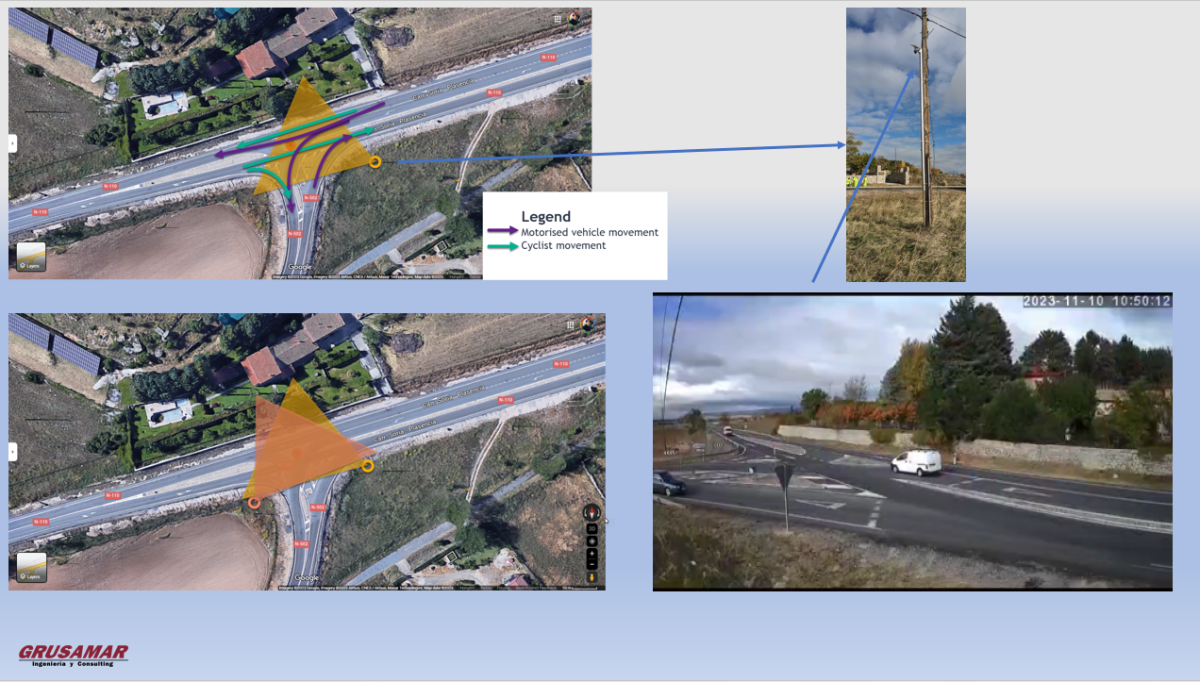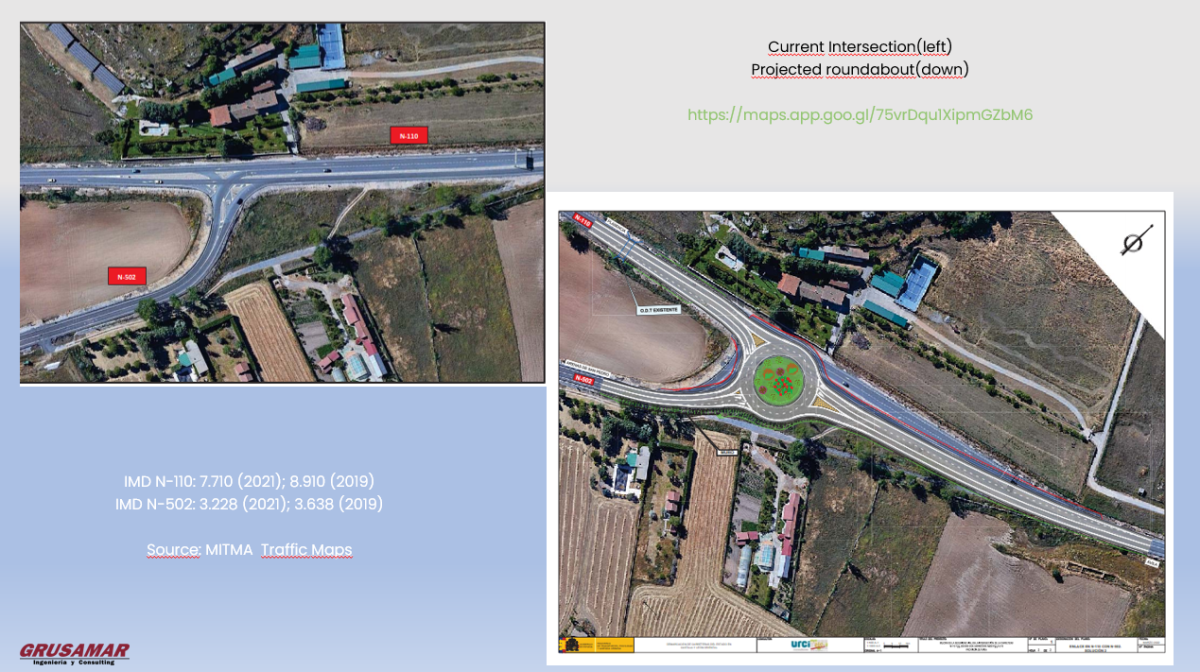Initiative details
The safety and interaction of cyclists during infrastructure conservation and repair works are significantly impacted by changes made, potentially leading to new conflicts between cyclist traffic and vehicles.
The BIKEFLOW project's objective is to enhance cyclist safety in critical areas identified within modified sections during ongoing conservation efforts. By employing video analytics and Artificial Intelligence, we can examine the movements and potential interactions of cyclists and vehicles. This technology utilizes video analysis to forecast safety levels before incidents happen, enabling the identification of vehicles, routes, and speeds, with the capability to present data in real-time or upon request. In light of these analyses, permanent cameras have been installed at the junction of N-110 and N-502 to conduct surrogate safety assessments. This involves applying various configurations to the route to analyze the behavior of road users (both vehicles and cyclists) and to train an AI model that determines the most suitable layout configuration. The findings are then applied to adjust signage, lower speed limits, establish protected lanes at critical junctures, or modify paths as necessary.
The BIKEFLOW project's objective is to enhance cyclist safety in critical areas identified within modified sections during ongoing conservation efforts. By employing video analytics and Artificial Intelligence, we can examine the movements and potential interactions of cyclists and vehicles. This technology utilizes video analysis to forecast safety levels before incidents happen, enabling the identification of vehicles, routes, and speeds, with the capability to present data in real-time or upon request. In light of these analyses, permanent cameras have been installed at the junction of N-110 and N-502 to conduct surrogate safety assessments. This involves applying various configurations to the route to analyze the behavior of road users (both vehicles and cyclists) and to train an AI model that determines the most suitable layout configuration. The findings are then applied to adjust signage, lower speed limits, establish protected lanes at critical junctures, or modify paths as necessary.
Initiative date
Who was/is your target audience?
Public authorities
Company employees
Car drivers
Car drivers – professional
Van drivers
Lorry/truck drivers
Cyclists
Others
Topic
Create awareness
Improve vehicles and infrastructure
Knowledge building and sharing
Provide alternative solutions
Training
Organisation details
Elsamex
Enterprise
Spain
MADRID
Contact name
Miguel Paredes Sánchez
Telephone number
+34 626 589 531
miguel.paredes@elsamex.com
Website link
Project activities
If you work together with external partners, list the most important partners and briefly describe their role.
In collaboration with TRANSOFT SOLUTIONS, we utilized their cutting-edge Traffic Safety solutions to analyze video-sourced data, enabling us to swiftly identify safety issues tailored to our specific use cases. This technology facilitated the detection of perilous interactions between vulnerable road users, such as cyclists, and motor vehicles. This capability is instrumental in predicting, diagnosing, and mitigating various traffic safety challenges proactively, rather than relying on historical crash data.
The TRAFXSAFE software was pivotal in its proactive analysis feature, which allows for the early identification of potential collision scenarios by considering all site conditions. The successful outcomes of this collaboration have solidified our confidence in the advanced potential for traffic safety analysis. We are committed to continuing our work with both the software and TRANSOFT SOLUTIONS in our future and ongoing projects, aiming to elevate safety standards to new heights.
The TRAFXSAFE software was pivotal in its proactive analysis feature, which allows for the early identification of potential collision scenarios by considering all site conditions. The successful outcomes of this collaboration have solidified our confidence in the advanced potential for traffic safety analysis. We are committed to continuing our work with both the software and TRANSOFT SOLUTIONS in our future and ongoing projects, aiming to elevate safety standards to new heights.
Please describe the project activities you carried/are carrying out and the time period over which these were implemented.
1. Identifying the Problem or Need.
We recognized a necessity in our road works and maintenance operations and resolved to act.
2. Conflict Zone Analysis.
We selected the initial areas for intervention and established PET (Post Encroachment Time) as our primary KPI: the duration between a user vacating a conflict point on a road and another user arriving at that point.
3. Camera Setup and Installation.
We initiated the first trial with stationary cameras at the N110 and N502 intersection.
4. Video Capture and Processing.
Data was gathered over a period of two months.
5. Algorithm Application/Data Collection.
Data was processed using Transoft software, including cyclist and vehicle information.
6. Data Visualization/Road Safety Reports.
We prepared various reports (flow analysis, road safety, recommendations).
7. Results Presentation.
We analyzed and discussed the results and made decisions regarding the preparation and execution of the work.
8. Results Analysis.
Has the problem been fully comprehended? Do the results align with expectations?
We recognized a necessity in our road works and maintenance operations and resolved to act.
2. Conflict Zone Analysis.
We selected the initial areas for intervention and established PET (Post Encroachment Time) as our primary KPI: the duration between a user vacating a conflict point on a road and another user arriving at that point.
3. Camera Setup and Installation.
We initiated the first trial with stationary cameras at the N110 and N502 intersection.
4. Video Capture and Processing.
Data was gathered over a period of two months.
5. Algorithm Application/Data Collection.
Data was processed using Transoft software, including cyclist and vehicle information.
6. Data Visualization/Road Safety Reports.
We prepared various reports (flow analysis, road safety, recommendations).
7. Results Presentation.
We analyzed and discussed the results and made decisions regarding the preparation and execution of the work.
8. Results Analysis.
Has the problem been fully comprehended? Do the results align with expectations?
In terms of implementation, what worked well and what challenges did you need to overcome?
The project is currently in progress, and we are in the process of fully understanding the capabilities of the technology. The primary challenge we are encountering is the learning curve associated with configuring the cameras (angles, height, etc.) and the necessary lighting conditions for the software to function effectively.
The outcomes to date have been very promising, yielding a wealth of constructive feedback regarding various solutions we could adopt. These solutions have significant implications for the safety of our operations during road repairs and maintenance in areas with mixed traffic, including cyclists and vehicles.
The initial deployment of our traffic management solution has met with success, prompting plans for its expansion to accommodate roads experiencing higher traffic volumes. This decision follows positive reception and a clear demand for scaling up the implementation in the forthcoming years.
The outcomes to date have been very promising, yielding a wealth of constructive feedback regarding various solutions we could adopt. These solutions have significant implications for the safety of our operations during road repairs and maintenance in areas with mixed traffic, including cyclists and vehicles.
The initial deployment of our traffic management solution has met with success, prompting plans for its expansion to accommodate roads experiencing higher traffic volumes. This decision follows positive reception and a clear demand for scaling up the implementation in the forthcoming years.
Evaluation
Please summarise how you have evaluated the initiative’s impact (e.g. social media reach, survey, feedback forms, statistics).
The success of this internal project is gauged by the decrease in incidents during our case use demonstrations, which has garnered considerable appreciation. The solution has been showcased across various meetings with our end-users and clients, eliciting overwhelmingly positive feedback.
What has been the effect of the activities?
The implementation of our solution is ongoing, yet we have already made adjustments to our operations at both regional and national levels. We anticipate broadening its application across more of our current activities as soon as the proof of concept is complete and meets our satisfaction criteria.
Please briefly explain why your initiative is a good example of improving road safety.
By analyzing before the intervention, measuring interactions, and projecting future scenarios, we can diminish the incidence of safety issues by implementing measures that are normally unpredictable. These best practice measures can serve as a model for other administrations to incorporate such analysis into their planned works and interventions. We hope this experience will encourage others to employ this technology for planning around predicted issues that are otherwise challenging to foresee without this AI technology.
How have you shared information about your project and its results?
The solution has been deliberated both within our organization and with various public entities and infrastructure administrators.
We have disseminated the findings of the current project to engaged stakeholders and via our internal website.
https://elsamex.com/transoft/
Additionally, we have presented the ongoing project and the accumulated results to our public clientele and other potential interested parties.
We have disseminated the findings of the current project to engaged stakeholders and via our internal website.
https://elsamex.com/transoft/
Additionally, we have presented the ongoing project and the accumulated results to our public clientele and other potential interested parties.
Supporting materials


